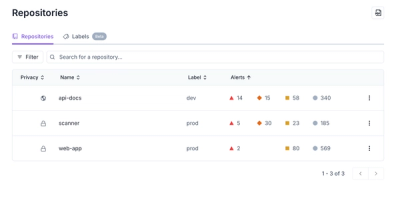
Product
Redesigned Repositories Page: A Faster Way to Prioritize Security Risk
Our redesigned Repositories page adds alert severity, filtering, and tabs for faster triage and clearer insights across all your projects.
dynamic-xml-builder
Advanced tools
Build XML dynamically.
Looking through the NPM trying to find an intuitive way to declare XML using JSON objects and all I see is a $#1tload of bad syntax design. Why is it so hard to first design the syntax and then the desired functionality around it? The developers are the users, one should know to program for their convenience.
So here's another attempt at an XML builder...
Write this
const XMLObject = require('dynamic-xml-builder');
var xml = new XMLObject('html');
// assign an attribute
xml._lang = 'en';
// assign a whole object
xml.head = {
meta: {
_charset: 'utf-8'
}
}
// go deeper
xml.head.title = 'example'
// or more complex
xml.body = {
div: {
_class: 'my-design',
p: [
'hello', 'how', 'are', 'you'
],
br: null
}
}
// or even do this
xml.body.div.div.p = 'great'
and with
xml.toXML();
get that:
<html lang="en">
<head>
<meta charset="utf-8"/>
<title>example</title>
</head>
<body>
<div class="my-design">
<p>hello</p>
<p>how</p>
<p>are</p>
<p>you</p>
<br/>
<div>
<p>great</p>
</div>
</div>
</body>
</html>
or with
xml.toXML({
indent: 2, newLine: '\n'
})
this:
<html lang="en">
<head>
<meta charset="utf-8"/>
<title>example</title>
</head>
<body>
<div class="my-design">
<p>hello</p>
<p>how</p>
<p>are</p>
<p>you</p>
<br/>
<div>
<p>great</p>
</div>
</div>
</body>
</html>
Every element in the object tree (except for assigned primitive values) is an XMLObject. Therefore the same functionality applies to those objects:
xml.head.toXML()
<head>
<meta charset="utf-8"/>
<title>example</title>
</head>
xml.head.toObject()
{ head: { meta: { _charset: 'utf-8' }, title: 'example' } }
PS. The examples include a lot of HTML, this library is not intended for composing HTML.
Since this is based on ES6 proxies, then ES6 support is required:
new XMLObject('html')
new XMLObject('html', {head: {}, body: {}})
new XMLObject('html', {head: {}, body: {}}, ...options)
new XMLObject({html: {head: {}, body: {}}})
new XMLObject({html: {head: {}, body: {}}}, ...options)
Different options can be passed to the constructor or toXML(options) method
| Name | Default | Usage | Description |
|---|---|---|---|
| attrSel | "_" | constructor | used to identify attributes (attrSel + attributeName, i.e. "_charset") |
| defVal | "" | constructor | default value to use when element value has not been provided |
| indent | "\t" | toXML | indent definition, can be any string |
| newLine | "\r\n" | toXML | newline definition, can be any string |
| attrKey | null | toXML | when provided, will group the attributes of an element under attrKey object |
| declaration | null | toXML | provide true for the default declaration, or any string to override it |
node test
MIT
FAQs
dynamic XML builder
The npm package dynamic-xml-builder receives a total of 118 weekly downloads. As such, dynamic-xml-builder popularity was classified as not popular.
We found that dynamic-xml-builder demonstrated a not healthy version release cadence and project activity because the last version was released a year ago. It has 1 open source maintainer collaborating on the project.
Did you know?

Socket for GitHub automatically highlights issues in each pull request and monitors the health of all your open source dependencies. Discover the contents of your packages and block harmful activity before you install or update your dependencies.

Product
Our redesigned Repositories page adds alert severity, filtering, and tabs for faster triage and clearer insights across all your projects.

Security News
Slopsquatting is a new supply chain threat where AI-assisted code generators recommend hallucinated packages that attackers register and weaponize.

Security News
Multiple deserialization flaws in PyTorch Lightning could allow remote code execution when loading untrusted model files, affecting versions up to 2.4.0.